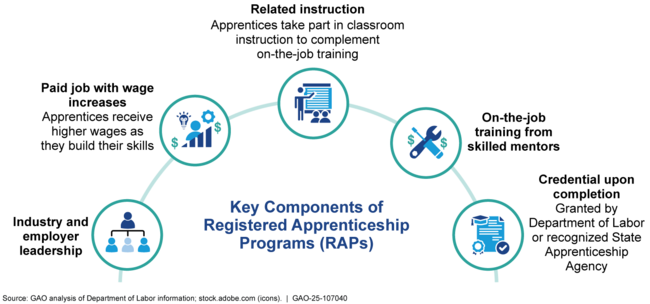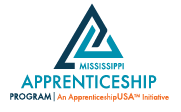Originally posted by U.S. Government Accountability Office on Apr 28, 2025. Publicly Released: May 28, 2025.
This Q&A examines earn-and-learn opportunities, which can give individuals a mix of work experience and instruction on in-demand skills—while they earn a wage.
We found at least 26 federal programs that can help provide these opportunities. For example, the Labor Department and state partners oversee Registered Apprenticeship Programs, which enrolled about 940,000 people in FY 2024. These programs can lead to higher pay, produce little student debt, and increase employee retention.
Employers cited concerns about administrative burden and cost as potential barriers to expanding these programs.

Highlights
What GAO Found
Earn-and-learn opportunities generally provide workers and jobseekers looking to gain in-demand skills a mix of practical work experience and other instruction, while still allowing them to earn a wage. While these opportunities may include apprenticeships, pre-apprenticeships, internships, and work-study, the available research and evidence largely concerns Registered Apprenticeship Programs (RAP). RAPs are structured earn-and-learn opportunities that provide participants on-the-job training and mentorship, classroom instruction, progressive wage increases, and a credential from the Department of Labor (DOL).
GAO identified at least 26 programs across five federal agencies (Departments of Commerce, Defense, Education, Labor, and Veterans Affairs) that could support earn and learn, including DOL’s Office of Apprenticeship. Examples of support include registering and setting standards for apprenticeships, providing funding to employers, participants, and training providers, and supporting earn-and-learn opportunities for certain populations or industries. GAO identified some examples of past and ongoing coordination among federal agencies supporting earn and learn, including the establishment of an inter-agency committee to support apprenticeships.
RAPs have historically provided federally registered earn-and-learn opportunities to workers in construction and the skilled trades, but are expanding among other occupations. In fiscal year 2024, about 940,000 workers participated in RAPs across a variety of industries that include construction, technology, advanced manufacturing, healthcare, and energy. RAP demographics largely reflect those of the construction industry, which makes up nearly half of all RAP participation. Overall, in fiscal year 2024 about 84% of RAP participants were male and 74% were white, among those who reported gender or race, respectively. GAO also found RAP participants were generally in high-growth and high-wage occupations such as electricians and computer occupations. Specifically, of the 10 most common RAP occupations, six were projected to grow faster than the average occupation by 2033. Nine also paid above median wages for all workers, according to 2023 Bureau of Labor Statistics (BLS) data.
DOL, which along with State Apprenticeship Agencies registers and sets standards for RAPs, reported that between April 2022 and March 2023, RAP completers earned average annual wages of about $80,000 their first year after exiting their program. Those average wages were higher than those of associate’s degree holders, according to BLS data on average annual wages.
RAP sponsors must demonstrate that their voluntary, industry-led program includes certain key components to register their program with DOL or one of its recognized State Apprenticeship Agencies. (See figure.)
Figure: Key Components of Registered Apprenticeship Programs

Earn-and-learn opportunities, including RAPs, may confer benefits to participants and employers, according to research and stakeholders GAO spoke with.
- Benefits for participants include increased wages, access to occupation-relevant education that leads to a credential, and the potential to avoid taking on student loan debt.
- Benefits for employers include higher employee retention and the ability to fill workforce gaps. Research notes that employers may experience a positive return on investment from RAPs, in particular.
Stakeholders identified several barriers to the expansion of earn-and-learn opportunities, including RAPs. These barriers include awareness gaps among employers and jobseekers and concerns among employers about administrative burden and cost. Federal agencies have implemented several recent initiatives to address these challenges. For instance, DOL contracts with industry intermediaries to serve as RAP sponsors, which can reduce the administrative burden on individual employers.
Why GAO Did This Study
GAO was asked to examine federal support for earn-and-learn opportunities. This Q&A report examines how specific federal programs support earn-and-learn opportunities such as apprenticeship, how these federal programs coordinate and target industries with projected growth, and the benefits and challenges associated with apprenticeship and other earn-and-learn opportunities.
GAO sent a questionnaire to officials at DOL, Commerce, DOD, Education, and VA on their programs’ support for earn and learn. GAO also analyzed fiscal year 2024 data from DOL on RAP participation, 2023 BLS data on wages and occupational growth projections, and the results of a 2020 Education survey of a nationally representative sample of college students. These were the most recent data available at the time of GAO’s analysis and were sufficiently reliable for GAO’s purposes. In addition, GAO analyzed relevant studies and interviewed earn-and-learn stakeholders—including nine employers, 11 earn-and-learn participants, eight federal and state agencies, and 13 other workforce organizations—about their experiences with earn-and-learn opportunities.
For more information, contact John D. Sawyer at sawyerj@gao.gov.
